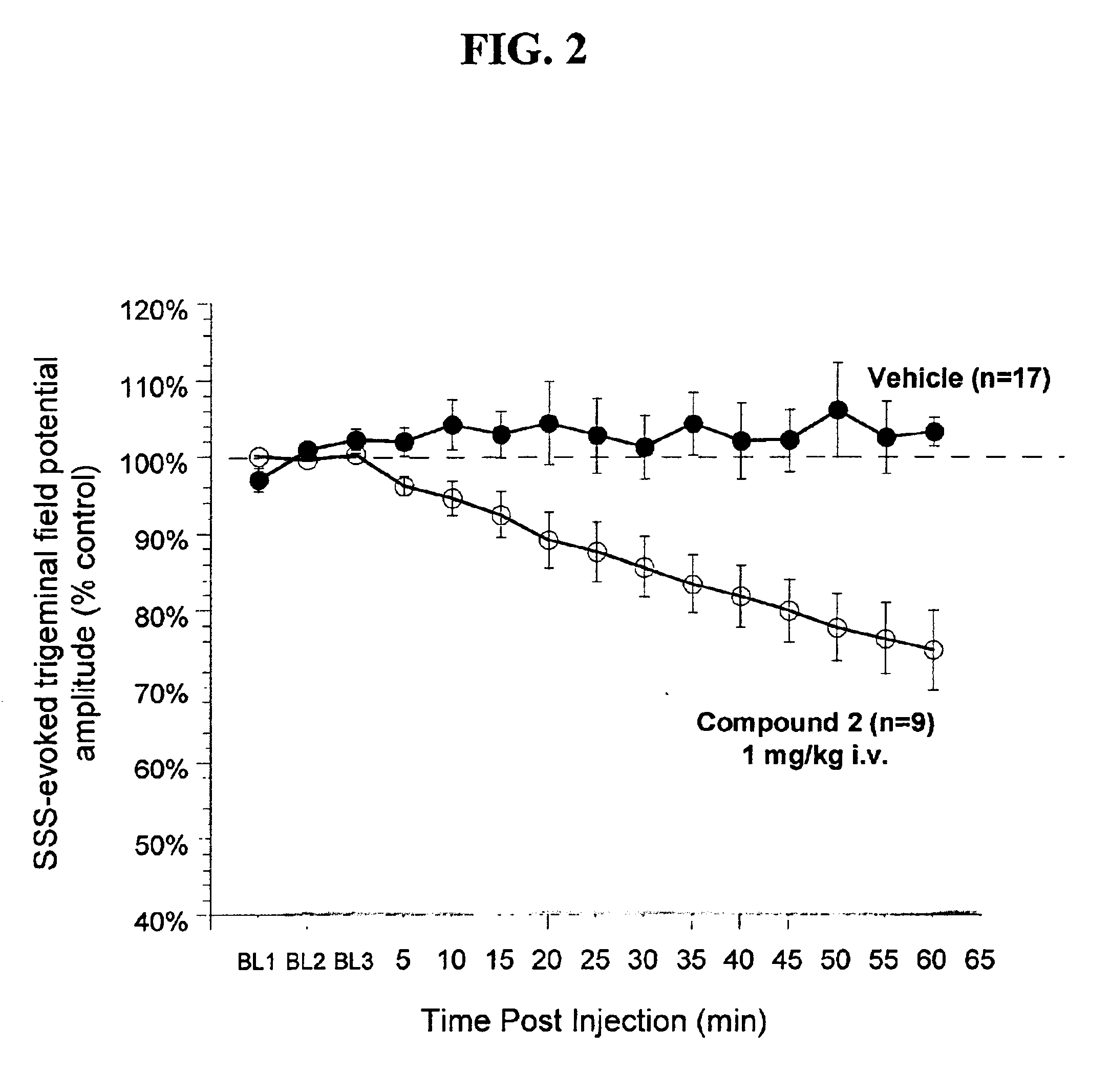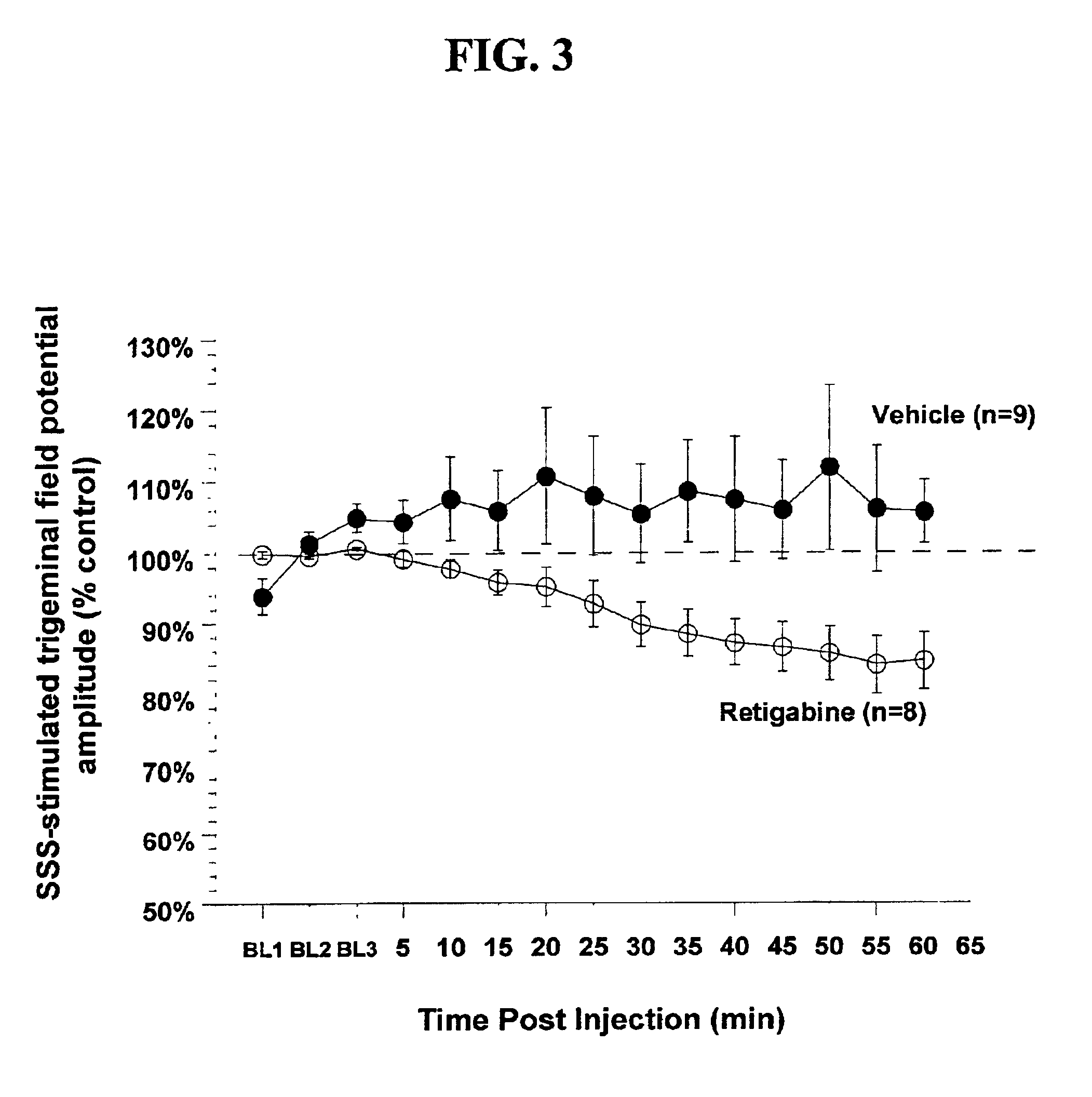3-fluoro-2-oxindole modulators of KCNQ potassium channels and use thereof in treating migraine and mechanistically related disease
a potassium channel and kcnq technology, applied in the field of kcnq family of potassium channels, can solve the problems of migraine attacks, episodic migraine attacks, self-limited, and hyperexcitation
- Summary
- Abstract
- Description
- Claims
- Application Information
AI Technical Summary
Benefits of technology
Problems solved by technology
Method used
Image
Examples
example 1
Fluorooxindole KCNQ Opener Compound Synthesis / Preparation
In this Example, as in Example 2, all temperatures are given in degrees Centigrade. Melting points were recorded on a Gallenkamp capillary melting point apparatus; temperatures are uncorrected. Proton magnetic resonance (1H NMR) was recorded on a Bruker AC 300. All spectra were determined in the solvents indicated and chemical shifts are reported in δ units downfield from the internal standard, tetramethylsilane (TMS), and interproton coupling constants are reported in Hertz (Hz). Splitting patterns are designated as follows: s, singlet; d, doublet; t, triplet; q, quartet; m, multiplet; br, broad peak; dd, doublet of doublet; bd, broad doublet; dq, doublet of quartet. Infrared (IR) spectra using potassium bromide (KBr) were determined on a Perkin Elmer 781 spectrophotometer from 4000 cm−1 to 400 cm−1, calibrated to 1601 cm−1 absorption of a polystyrene film and reported in reciprocal centimeters (cm−1). Low resolution mass spe...
example 2
2-(Pyrrolidin-1-yl)-4-(trifluoromethyl)-N-[[4-(trifluoromethyl)phenyl]methyl]pyrimidine-5-carboxamide KCNQ Opener Compound Synthesis / Preparation
Preparation of 2-(Pyrrolidin-1-yl)-4-(trifluoromethyl)-N-[[4-(trifluoromethyl)phenyl]methyl]pyrimidine-5-carboxamide (Compound 2)
To a solution of 2-chloro-4-(trifluoromethyl)pyrimidine-5-carbonyl chloride (0.74 g, 3.0 mmol) in dichloromethane (5 mL), was added saturated sodium bicarbonate (5 mL) and 4-(trifluoromethyl)benzylamine (0.58 g, 3.3 mmol). The reaction mixture was stirred at room temperature for 3 hours. The precipitated white solid of 2-chloro-4-(trifluoromethyl)-N-[[4-(trifluoromethyl)phenyl]methyl]pyrimidine-5-carboxamide was collected by filtration and then dissolved in acetonitrile (10-15 mL). Potassium carbonate (0.62 g, 4.5 mmol) and pyrrolidine (0.43 g, 6 mmol)) were added. The reaction mixture was stirred at room temperature overnight. The inorganic salts were filtered off and the filtrate was concentrated in vacuo to prov...
example 3
Materials and Methods
Male Long-Evans rats (Harlan, 250-400 g) were used in the experiments described in this example. Prior to testing, rats were allowed access to food and water ad libitum and were maintained on a 12:12 hours light / dark cycle. Rats were group housed in an Association for Assessment and Accreditation of Laboratory Animal Care (A.A.A.L.A.C.) accredited facility and cared for in strict compliance with all applicable regulations.
Cortical Spreading Depression
Rats were anesthetized with urethane anesthesia (1.2 g / kg i.p.), implanted with a jugular vein catheter for drug injections, and placed in a stereotaxic frame. The skull was exposed and a small hole (approximately 2 mm by 3 mm) was drilled in the skull rostral to the lambdoid suture using a microdrill and steel burr creating a “well”. The dura was disrupted and a drop of mineral oil was placed in this well. Crystalline KCl was later applied to the well for 10 minutes to elicit spreading depr...
PUM
 Login to View More
Login to View More Abstract
Description
Claims
Application Information
 Login to View More
Login to View More - R&D
- Intellectual Property
- Life Sciences
- Materials
- Tech Scout
- Unparalleled Data Quality
- Higher Quality Content
- 60% Fewer Hallucinations
Browse by: Latest US Patents, China's latest patents, Technical Efficacy Thesaurus, Application Domain, Technology Topic, Popular Technical Reports.
© 2025 PatSnap. All rights reserved.Legal|Privacy policy|Modern Slavery Act Transparency Statement|Sitemap|About US| Contact US: help@patsnap.com



